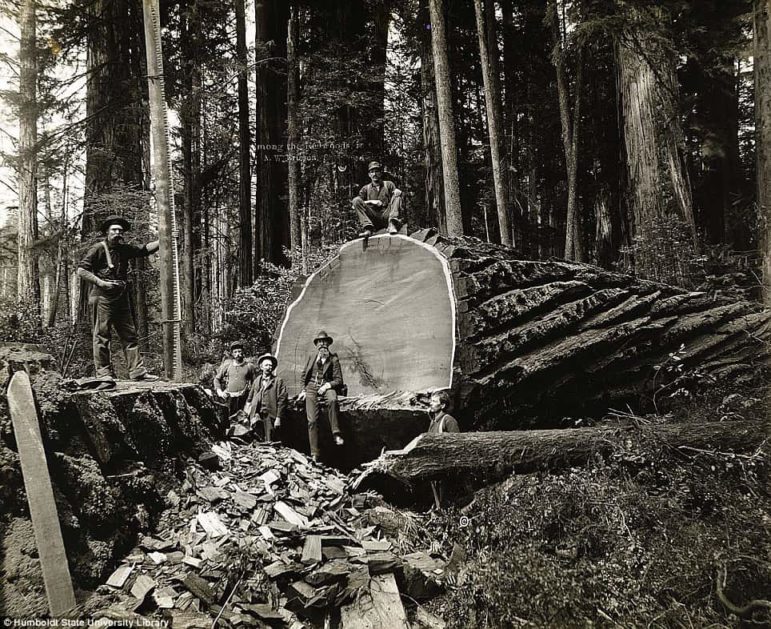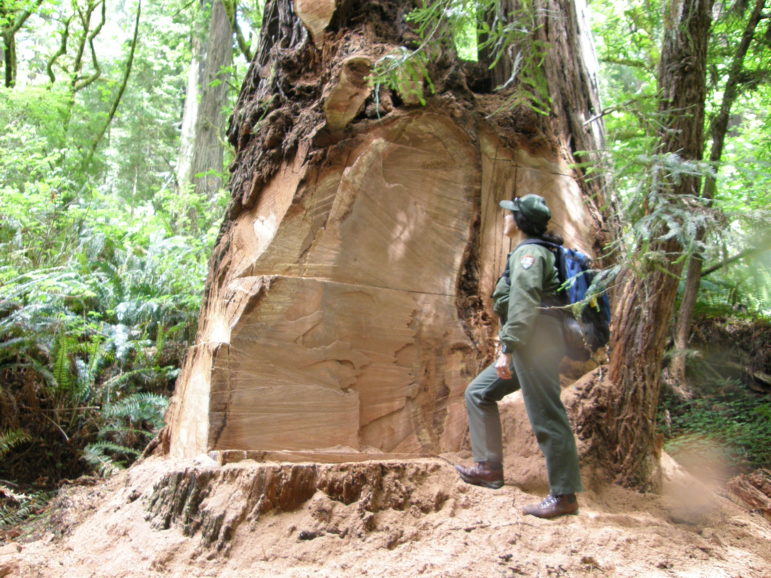ANAHEIM, Calif. – The coastal redwood forests that once flourished along vast stretches have dwindled to a meager percentage of their former glory. And every year, environmentalists, scientists, and California residents watch increasingly devastating wildfires rampage across the state. But there’s another threat that is damaging the embattled giant redwoods: tree theft.

Prairie Creek Redwoods State Park (2008) – Image credit: Owen Lloyd – Public Domain
Approximately 39 percent of all remaining old-growth redwood forest is located in Redwood National and State Parks in Northern California. But more than 95 percent of the old-growth redwoods have been harvested since settlers arrived en masse. Of the remaining five percent of that original old growth, 80 percent is protected within the state and national parks or reserves. Twenty percent of old-growth redwood remains unprotected.
Most of the redwood forests we see today are second-growth, meaning they have grown up within the last 150 years. In contrast, many old-growth redwood trees are thousands of years old. Redwood trees have been in California for at least 20 million years, but human activity nearly eliminated them, primarily through logging.

Lumberjacks standing next to a downed giant trunk by size comparison. (circa 1915) Image credit: Augustus William Ericson, 1848-1927; Richard Ericson, Edgar Ericson. – Humboldt State University Library – Public Domain
Despite national and state park protection, the redwoods are under assault again from poachers who hack off the burls. A tree burl is a round, large, woody swelling that many trees develop. Some scientists believe that a burl may be a defensive response to damage, but the cause is unknown in many cases.
A variety of consumers and manufacturers prize burl wood for its distinctive and unusual grain patterns. This type of wood is often used as detailing in luxury vehicle interiors, on knife handles, turned bowls, and even as large tabletops. Musical instrument manufacturers often seek burl wood for guitars and other stringed instruments.
The problem is that increasingly, the burl wood entering the market is illegally obtained by tree poachers. In many circumstances, people enter the state and federally-owned forests in the U.S. and forest reserves in British Columbia, Canada, to remove portions of redwoods and other old-growth trees. Often, this poaching occurs during the night. The poachers take chainsaws and saw the burls away from the trunk, sometimes cutting so deeply that the tree is permanently damaged or must be taken down altogether.
In recent years, the National Park Service has developed increasingly sophisticated methods for tracking would-be poachers, damaged trees, and potential targets. However, covering the vast acreages of forests is a monumental task, even for a full team of men and women. In many cases and locations, park rangers work solo or with a very small team.
In 2018, investigators tracked down and successfully prosecuted Derek Alwin Hughes of Orick, California, for redwood burl wood theft. In 2021 he received probation and is banned from entering Redwood National and State Parks, but will serve no jail time. Sentiments of those in the community, and especially those who followed the story were deeply divided on the judge’s lenient sentencing.
While the community of Orick and other towns in the area are often distrustful of armed park rangers acting as an additional layer of law enforcement, others felt the sentence was no more than a slap on the hand and that he and others would continue removing burls given the opportunity.
And it seems this is the case, as Oregon officials report increasing tree poaching activity. Conservation group Oregon Wild recently found evidence of burl theft in a Southwest Oregon redwood grove in the Rogue-Siskiyou National Forest. Although this area is a National Forest, it does not have a Wilderness designation and lacks strong legal protections. And Vancouver Island in British Columbia has seen a rash of tree poaching activity targeting Western red cedars and coastal Douglas firs.
Tree theft and burl poaching are terms that sound to many like they belong to wild, untamed parts of the globe. But these thefts are happening in state and national parks, and even sometimes on private land, and the burls and boards are flowing into mills and shops. Money, in this case, does grow on trees.
Redwood burls have always fetched great prices, and a raw burl chunk may be poached, cut into pieces, and sold to multiple shops or mills. While many shops and mills will demand to see the proper paperwork, not all do. And there are many cases, say officials when burl sellers or mills forge paperwork, or it goes “missing” when rangers ask to see it.
Skyrocketing timber prices have made tree poaching an even more lucrative activity. For example, the average price per thousand board feet of spruce, fir, or pine in British Columbia was $570 in 2020. By 2021, that average price was $1,420 per thousand board feet. And Western red cedar was going for an average of $1,700 per thousand board feet in 2021.
Lyndsie Bourgon wrote extensively about Derek Hughes and other poachers in the Orick area and the financial aspects of tree poaching in Tree Thieves: Crime and Survival in North America’s Woods. Experts estimate that tree poaching in North America amounts to at least $1 billion worth—possibly much more. A chunk of redwood burl can sell for as low as $450 or as high as $30,000 or more. Poachers can remove large burls in pieces in a single night of work or over the course of a couple of nights.
For many, the act of tree poaching and tree theft is a clear-cut violation and an environmental catastrophe. The poachers often target ancient, towering redwoods already under immense pressure from climate change and increasingly damaging wildfires. It can take several centuries for the redwoods to achieve their soaring growth and girth, and cutting out a burl creates several problems.
Often, poachers cut deeply into the heartwood, leaving the tree exposed to insects, fire, and weather and dooming the entire tree. In addition, burl wood contains concentrated genetic material. Burls are a source of regrowth and regeneration, even on fallen trees. Sprouts will often emerge from tree burls, so the tree’s genetic information can live on long after the original tree has succumbed to the natural elements. Removing the burl means the loss of this precious genetic material in rapidly shrinking groves.
However, many of the people poaching trees and entering the forests are from communities that have suffered now for decades as the predatory lumber industry pulled out of towns following pushing from environmentalists and state governments to regulate and protect the forests.
In some towns, several generations of loggers have struggled to move on or find ways to reinvent themselves when logging companies moved out. And in too many cases, drugs, multigenerational underemployment, and unemployment moved into the void. Towns that were promised tourism dollars from the nearby state and national forests have foundered when the tourism never came or bypassed them.

Redwood National Park, California, USA: A park ranger inspects a redwood tree, that has been vandalized to steal a burl (2013) – Image credit: NPS – – Public Domain
Another layer is that many loggers found themselves targeted by environmentalists and people who flooded into the area to protest the logging and timber industry. Logging companies told the loggers that those people were out to take their jobs and livelihoods away. Environmentalists and activists wanted logging companies to stop rampant overharvesting and hoped to preserve the last few great redwoods.
Now, there’s additional pressure on many depressed communities in Northern California and throughout Oregon and Washington from wildfires. These wildfires have become faster moving and more costly each year. Officials estimate that as of September 20, 2022, at least 365,140 acres have burned, and nine civilians have died during the current season.
Yet another year of severe drought is exacerbating the problem, as trees are too stressed to resist disease and insect damage. When lightning or human activity sparks a blaze, the trees and bone-dry underbrush burns hot and fast. At this time, only 0.23% of the state of California is not in a drought. Most of the state is classified as D3 or D4—extreme or exceptional drought. 2022 has been the driest year on record in the last 128 years.
The drought and the wildfires are also creating intolerable stress on many communities. In Central California, wells are going dry, and some farmers are forced to allow fields to fallow. In Northern California, wildfires have scorched entire communities and towns. Some poachers claim they only remove burls and wood from trees that have already fallen, whether due to natural causes or other poacher activity.
And after decades of complete prohibitions on logging in many areas, California fire management is shifting toward selective logging and forest thinning. A number of experts and ecologists say fire suppression policies have prevented natural burns that would thin the undergrowth. As the state feels the impacts of climate change more and more, the wildfires that rage through dense, drought-stricken forests.
Other forestry management projects may have contributed to the higher-intensity burns, including the extensive logging of old-growth giant redwoods and other established trees in the last 150 years. In their place, faster-growing and less fire-resistant trees like Douglas fir, as well as brushes and invasive grasses, find their footing.
Finally, many state agencies are turning to Native American practices and strategies for managing forests, but some experts worry that too much damage has been done. Many tribes, including the Yurok, have begun working with CAL FIRE to perform prescribed, controlled burns. They hope to restore an integral part of their identity and culture that was once inextricable with managing the forests in which they lived and worked.
Ecologists are also admitting that some logging may be beneficial to creating forests that can survive the longer wildfire seasons each year. In July of 2022, Tahoe Forest Products, LLC began constructing a multi-million dollar sawmill just over the border in Carson City, Nevada. But decades of pressure on loggers throughout the 20th century created many communities that are bitter, angry, and distrustful of both ecologists and the government. Many residents of the coastal California town of Yreka put the blame squarely on the government for repeated fires in the area, including the most recent and extremely destructive McKinney fire that killed four people.
Tree poaching continues. In April of 2022, in Humboldt County, California, poachers hacked out a chunk from a redwood within Humboldt Redwoods State Park. The burl, measuring four feet by three feet and gouging two feet into the trunk, appeared to have been removed quickly and messily. Authorities identified a light-colored Ford F250 they believe was involved, with no visible license plates. Burls, especially redwood burls, continue to fetch lucrative prices, and many communities are still experiencing endemic, generational economic challenges.
The realization that it’s vital we see both the forest and the trees seems to have been brought into focus and is getting more attention at a national level. It’s easy to wonder if there is enough time left to save the redwood forests.
The Wild Hunt is not responsible for links to external content.
To join a conversation on this post:
Visit our The Wild Hunt subreddit! Point your favorite browser to https://www.reddit.com/r/The_Wild_Hunt_News/, then click “JOIN”. Make sure to click the bell, too, to be notified of new articles posted to our subreddit.